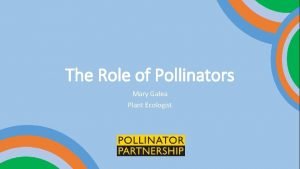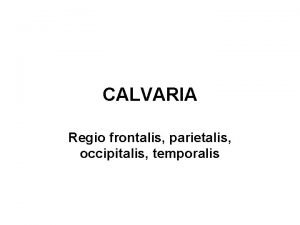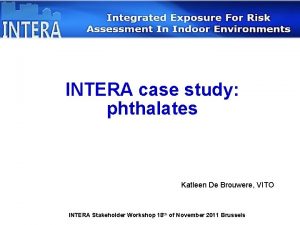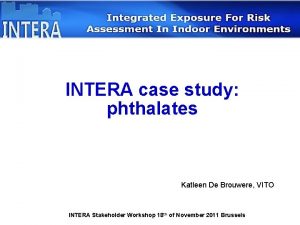INTERA Introduction to the case studies Karen Galea








- Slides: 8

INTERA Introduction to the case studies Karen Galea INTERA Stakeholder Workshop 18 th of November 2011 Brussels

Objectives • To apply the integrated assessment methodology (as described this morning) in 3 case studies • Case studies will be developed to: – Test the developed integrated methodology – Suggest any refining to the computational tools – Identify data gaps INTERA Stakeholder Workshop 18 th of November 2011 Brussels

Case studies outcomes • A synthesis report on (EU) population exposures for the three types of pollutants • Report on data gaps, research needs and need for further methodological refinements • Case studies ongoing, we present work so far INTERA Stakeholder Workshop 18 th of November 2011 Brussels

The need for a consistent methodology • Planned that case studies would follow a common framework to achieve identified outcomes – Consideration given to how it framework can be implemented for the case study pollutants – How framework can be used to test tools developed in INTERA Stakeholder Workshop 18 th of November 2011 Brussels

The case study steps…. • Step 1: Define the scope of the case study • Step 2: Identify for each contaminant main sources of emission (products) in residential settings. • Step 3: Dependent on route of exposure – Step 3 a: Emission indoor-air modelling (inhalation) – Step 3 b: Exposed area: uptake factor and dermal loading mechanism modelling (dermal) – Step 3 c: Oral exposure (oral) INTERA Stakeholder Workshop 18 th of November 2011 Brussels

The case study steps…. • Step 4: Exposure modelling. – Depending on data availability, data collected in previous steps used as input or in first step of the modelling chain implemented in the INTERA platform • • Step 5: Internal dose modelling Step 6: Addressing the deficits in data Step 7: Running the full chain platform Step 8: Interpreting and reporting the outputs INTERA Stakeholder Workshop 18 th of November 2011 Brussels

The three case studies • Dimethyl fumarate (DMF) through dermal exposure • Phthalates through multi-pathway exposures • BTEX (benzene, toluene, ethylbenzene, and xylenes) with mixture effect • Individual presentations on progress of each case study will be given INTERA Stakeholder Workshop 18 th of November 2011 Brussels

Common values • To increase comparability the three case studies used the following common values: – – – Time activity patterns Air Exchange Rates in residencies and workplaces Volume of residencies and workplaces Body dimensions (length, weight and surface area) Inhalation rates INTERA Stakeholder Workshop 18 th of November 2011 Brussels















